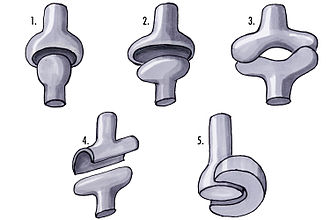Hinge joint

== Hinge Joint ==
A hinge joint is a type of synovial joint that exists in the human body and other animals. It allows movement primarily in one plane, similar to the motion of a door hinge. This type of joint is characterized by its ability to permit flexion and extension, with very limited rotation or other movements.
Structure[edit]
Hinge joints are composed of several key components:
- Articular cartilage: This smooth, white tissue covers the ends of bones where they come together to form joints. It enables bones to move smoothly against each other.
- Synovial membrane: This membrane lines the joint and secretes synovial fluid, which lubricates the joint.
- Ligaments: These are strong, fibrous tissues that connect bones to other bones and provide stability to the joint.
- Joint capsule: This is a sac-like structure that encloses the joint, providing additional stability and protection.
Examples[edit]
Some common examples of hinge joints in the human body include:
- Elbow joint: This joint connects the humerus in the upper arm to the ulna in the forearm.
- Knee joint: This joint connects the femur in the thigh to the tibia in the lower leg.
- Ankle joint: This joint connects the tibia and fibula in the lower leg to the talus in the foot.
- Interphalangeal joints: These are the joints between the phalanges (bones) of the fingers and toes.
Function[edit]
The primary function of hinge joints is to allow movement in one plane, which is essential for various activities such as walking, running, and lifting objects. The design of hinge joints provides both stability and flexibility, enabling efficient and controlled movements.
Clinical Significance[edit]
Hinge joints can be affected by various medical conditions, including:
- Arthritis: This is an inflammation of the joints that can cause pain, swelling, and reduced motion.
- Bursitis: This is an inflammation of the bursae, which are small fluid-filled sacs that cushion the bones, tendons, and muscles near the joints.
- Ligament injuries: These can occur due to trauma or overuse, leading to pain and instability in the joint.
See Also[edit]
References[edit]
<references group="" responsive="1"></references>
External Links[edit]
Ad. Transform your life with W8MD's Budget GLP-1 injections from $75


W8MD offers a medical weight loss program to lose weight in Philadelphia. Our physician-supervised medical weight loss provides:
- Weight loss injections in NYC (generic and brand names):
- Zepbound / Mounjaro, Wegovy / Ozempic, Saxenda
- Most insurances accepted or discounted self-pay rates. We will obtain insurance prior authorizations if needed.
- Generic GLP1 weight loss injections from $75 for the starting dose.
- Also offer prescription weight loss medications including Phentermine, Qsymia, Diethylpropion, Contrave etc.
NYC weight loss doctor appointmentsNYC weight loss doctor appointments
Start your NYC weight loss journey today at our NYC medical weight loss and Philadelphia medical weight loss clinics.
- Call 718-946-5500 to lose weight in NYC or for medical weight loss in Philadelphia 215-676-2334.
- Tags:NYC medical weight loss, Philadelphia lose weight Zepbound NYC, Budget GLP1 weight loss injections, Wegovy Philadelphia, Wegovy NYC, Philadelphia medical weight loss, Brookly weight loss and Wegovy NYC
|
WikiMD's Wellness Encyclopedia |
| Let Food Be Thy Medicine Medicine Thy Food - Hippocrates |
Medical Disclaimer: WikiMD is not a substitute for professional medical advice. The information on WikiMD is provided as an information resource only, may be incorrect, outdated or misleading, and is not to be used or relied on for any diagnostic or treatment purposes. Please consult your health care provider before making any healthcare decisions or for guidance about a specific medical condition. WikiMD expressly disclaims responsibility, and shall have no liability, for any damages, loss, injury, or liability whatsoever suffered as a result of your reliance on the information contained in this site. By visiting this site you agree to the foregoing terms and conditions, which may from time to time be changed or supplemented by WikiMD. If you do not agree to the foregoing terms and conditions, you should not enter or use this site. See full disclaimer.
Credits:Most images are courtesy of Wikimedia commons, and templates, categories Wikipedia, licensed under CC BY SA or similar.
Translate this page: - East Asian
中文,
日本,
한국어,
South Asian
हिन्दी,
தமிழ்,
తెలుగు,
Urdu,
ಕನ್ನಡ,
Southeast Asian
Indonesian,
Vietnamese,
Thai,
မြန်မာဘာသာ,
বাংলা
European
español,
Deutsch,
français,
Greek,
português do Brasil,
polski,
română,
русский,
Nederlands,
norsk,
svenska,
suomi,
Italian
Middle Eastern & African
عربى,
Turkish,
Persian,
Hebrew,
Afrikaans,
isiZulu,
Kiswahili,
Other
Bulgarian,
Hungarian,
Czech,
Swedish,
മലയാളം,
मराठी,
ਪੰਜਾਬੀ,
ગુજરાતી,
Portuguese,
Ukrainian
